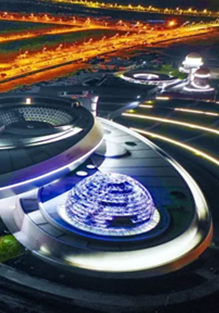Earlier this month, the brand new, state-of-the-art Shanghai Planetarium - the largest in the world - opened with an immersive, 3D sound specification from Merging Technologies.
Located by Dishui Lake in the Pudong New Area of Shanghai, the Planetarium spans an area of 58,603 square meters and a building area of 37,741 square meters. Promising customers a "complete view of the universe", the main exhibition area is made up three parts: Homeland, Universe and Journey, which provide a panoramic view of the universe and create a multi-sensory experience.
The Homeland exhibition area invites visitors to view the earth, moon and sun, before walking across the solar system. The Universe exhibition area presents the the universe in a panoramic view from the dimensions of time and space, light, gravity, elements and life, while the Journey exhibition area illustrates the journey of human exploration of the universe, as well as a vision of the future development of astronomy and space exploration.
The ‘What If’ theatre, located in the Universe exhibition area, uses a highly immersive 360-degree circular screen with 7.1.4 3D immersive sound to create an enveloping universe for the audience. The sophisticated AV design and production for the immersive experience of the ‘What If’ theatre was handled by Shanghai Magic Digital Creative Technology (Magic Digital).
The 7.1.4 speaker layout of the theatre was made specifically with the architectural structure and sound field of the theatre in mind, and does not meet any existing audio production standards (such as Dolby Atmos or Auro 3D). As a standard "user-defined" environment, the layout posed a problem for Magic Digital. At the beginning of demo production, whenever sound effects producers took audio files mixed in a standard surround sound recording studio and played them in situ, they were always "very different" from what they had heard during production due to the different placement of the speakers.
In typical surround sound recording studios, the lack of sky channels compromises the live effect of immersive sound, and the project site came only with a replay environment and no production equipment. Following much back and forth between Magic Digital staff and the recording studio and the planetarium, there was still no method for producing satisfactory immersive audio effects.
After studying onsite sound reinforcement and immersive sound production systems, sound designer Chen Baizhou specified a Merging audio production solution.
Based on the Dante, Magic Digital utilised the Pyramix MassCore audio workstation system based on the RAVENNA protocol as the core of audio production with a Merging+Hapi system handling the outputs. Through the AES67 protocol, the two are successfully connected onsite in the Dante Controller. As such, the theatre speakers essentially become monitor speakers for the sound effects production. The sound effects producer uses the "user-defined" bus function in Pyramix to input the position of the live speakers into the software one by one, so that in the Pyramix audio workstation they have a 3D immersion that is identical to the live speaker layout and position.
Through the processing of more than 100 audio tracks and dozens of effect plugins, a 12-channel 7.1.4 3D immersive sound file of the ‘What If’ theatre version of the Shanghai Planetarium was finally completed.
The final immersive sound file was described by the audio team as ‘perfectly fitting the live acoustic conditions and speaker layout to achieve an optimum 3D experience’.

